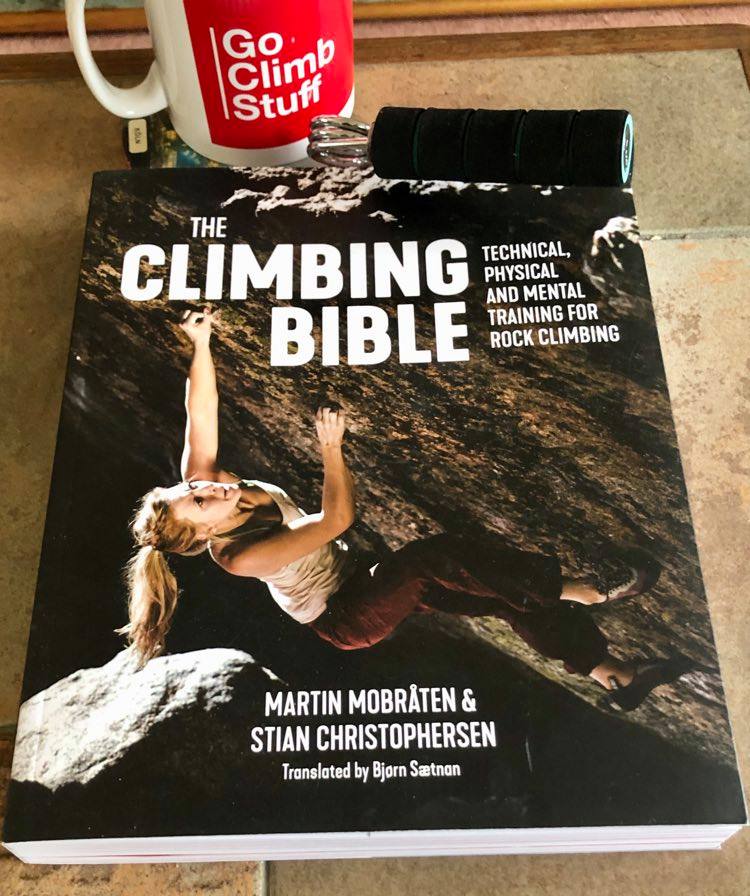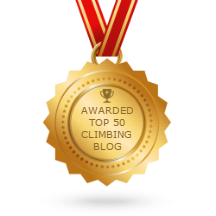Over the past decade, literature on training for climbing has developed substantially. There are many popular books, like 9 out of 10 Climbers, The Rock Warrior’s Way and Training for Climbing.
The Climbing Bible is a new comprehensive guide to help you train effectively to become a better climber. It’s has two authors: Martin Mobråten and Stian Christophersen. Both have climbed to a high standard and have a strong background in coaching. The Climbing Bible is divided into six classic categories: Technique, Physical Training, Mental Training, Tactics, General Training and Injury Prevention & Training Plans. But first - the Introduction. It's brief and simple, with a lovely reminder that we can play and train at the same time.
Technique
The images to go with each technique at the start are clear. The descriptions are a perfect intro for anyone who is new to climbing, with a good explanation behind each technique and why you should do it in this way. This nicely develops into some slightly more complicated techniques to develop, once you’ve mastered the basics - in particular, body positioning and jamming. There’s even some advanced ‘comp style’ movements.
This chapter has some truly fantastic information to hand. My only criticism is that I’d have liked to see the authors follow through on the ‘play’ concept in their Introduction, and provide games or drills which would be useful - especially for newer climbers - in the earlier stages of the chapter.
Physical Training
This is one of the most talked-about areas in climbing. Back in the 1980’s and 90’s, people like Wolfgang Gullich, Ben Moon and Jerry Moffatt were at the forefront of Physical Training - but without the scientific knowledge. It’s great that this chapter kicks off with a subject that is currently at the forefront of many discussions; weight loss! I’m a big fan that this book recommends that you climb with the body that you have.
After this, the chapter dives straight into fingerboard training and an interview with Eva Lopez on her research. There are different fingerboard strategies recommended by different people, but the principles are the same: the greater the intensity or load, the less time you hang for, the fewer reps and the longer you rest. I think this chapter reinforces many great exercises for Physical Training that are specific to - and very useful for - climbing. It incorporates some fun movement-based exercises, rather than just hardcore scientific training. However, you also have this, for those who love the science behind training.

Mental Training
This chapter features a good introduction on the basics to mental training. In particular, it reinforces the point, ‘we need to fail to progress.’ We are all unique in our approaches to mental tactics; what works for one person will not work for another, so to have differing advice within the book does mean there will be more potential to find the advice that best suits the reader. If you want a taster into some of the mental techniques used in climbing, this chapter is a great start.
Tactics
I really liked this chapter, which is a nice addition with plenty of anecdotal experience from Stian and Magnus Midtbo. This ties in nicely with the Mental Training Chapter, and I think there’s actually some overlap between the two. It has plenty of information about how to be smarter when trying climbs, such as breaking it down into onsighting, redpointing and flashing boulder problems or routes, and little about competition preparation. It also looks at skin care, optimal sending conditions and temperatures, and has some great insights into this. For me, the take away point from this chapter is that we have to find motivation through mastery, and focus on the process rather than the results. In pushing ourselves to fail, we have more chance at success.
Training and Injury Prevention
There's now a wealth of knowledge and information on how to train our antagonistic muscles for climbing. This book gives a great introduction to some exercises as a starting point, but it also includes exercises for the knees - a fantastic addition and an often-forgotten area of potential injury. I found this chapter incredibly interesting to read; the explanations for loading and training progressively are clear, it explains reasons behind an injury, and the subsequent exercises we can do. However, what I liked most about this chapter is the new thoughts on RICE or POLICE.
RICE stands for Rest, Ice, Compression, Elevation.
POLICE stands for Protection, Optimal Loading, Ice Compression, and Elevation
This chapter also discusses whether we should be resting completely if we’re injured, and talks about using Optimal Loading so that we don’t hit a repetitive cycle of injury. I also found the information on pain fascinating. It talks about how our mind will use pain as a defence mechanism, but we need to interpret the pain response to assess if it’s dangerous or not.
At the end of this chapter you also get an inspiring story from Rannveig Aamodt. I had the pleasure of meeting her a few years ago in Oliana. She had an awful accident in Turkey with many broken bones, but managed to find the motivation to come back in a spectacular way and push through the pain. She realised that pain creates fear, which can be very limiting. Eight months after the accident, she climbed her first Fr8a and has now climbed Fr8b+.
Training Plans
Personally, I’m a climber who sets goals, but I don’t have a highly structured training plan due to my work as a route-setter. I know what I want to train for each session, and I found my mind works better this way. This chapter gives a very good overview into training plan structures; perhaps it’s nothing ground-breaking but it reiterates relevant information. It also gives great examples on how to construct a training plan for a period of time, and clearly explains the loading and intensity necessary to progress. This is a useful chapter if you want to build your own training plan. Who better to interview at the end than Tom Randall? Tom is the founder of Lattice and comes from a successful training background, where hard work and dedication has paid off. He highlights that specificity is at the core of any decent training plan. In order to have that, we need to have goals. We also need to be highly analytical of our climbing, as outlined by the Strengths and Weaknesses chart from Tina.
This book has a fantastic structure, and each chapter develops from the basics to a slightly more advanced perspective. It is a beautiful book, with a clear layout and some great anecdotes throughout. It has incredibly useful information through each chapter, with enough to keep any keen climber busy and to give you ideas to focus on. It's a good start to developing your knowledge as a climber, if you don’t want to have an information overload. I think it’s worth reinforcing a great point made throughout this book: remember to have fun, remember to play whilst training your weaknesses, and surround yourself with people who radiate positivity.
The Climbing Bible is available to purchase for a SRP of £22.50 from Vertebrate Publishing.
From Vertebrate Publishing:
More and more people around the world are discovering how great climbing is, both indoors and outdoors. The Climbing Bible by internationally renowned climbers and coaches Martin Mobråten and Stian Christophersen is a comprehensive guide to help you train effectively to become a better climber.
Thanks to Emma Twyford for the review. Emma is available for route setting, and can be found on Instagram, Facebook and you can find more info on DMM Climbing. Emma is sponsored by DMM Climbing, Patagonia, Scarpa, Friction Labs and Climbskin, and is supported by V12 Outdoor.












